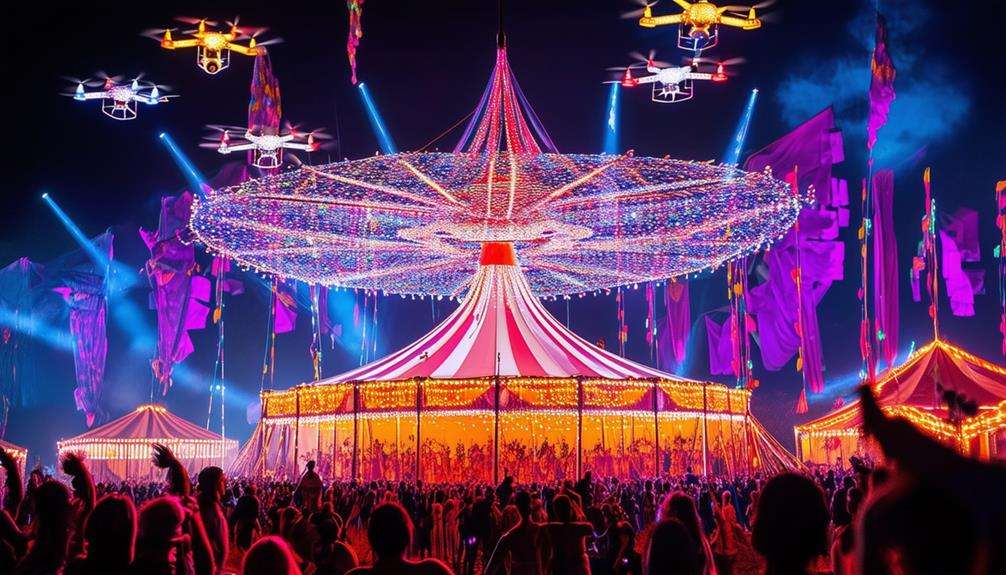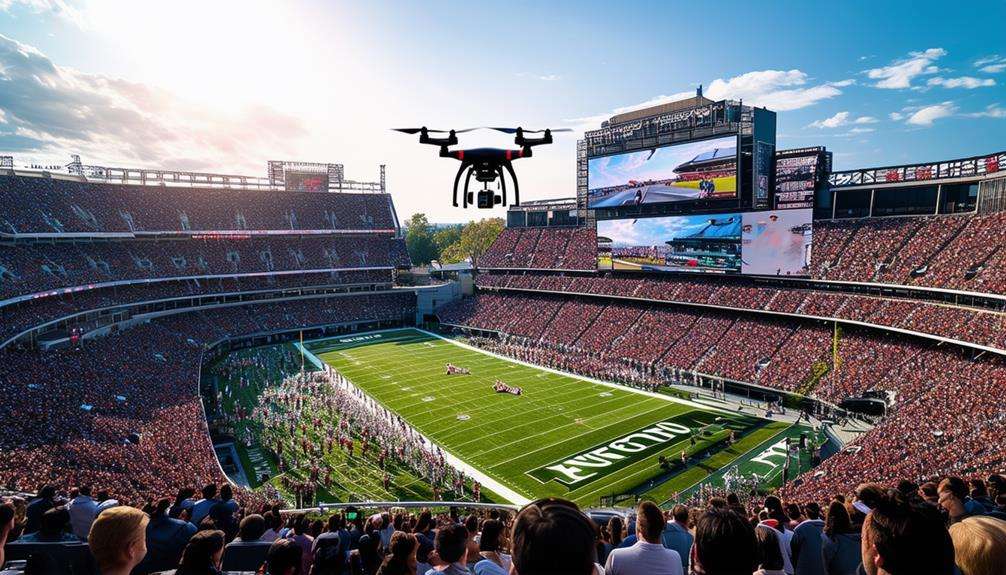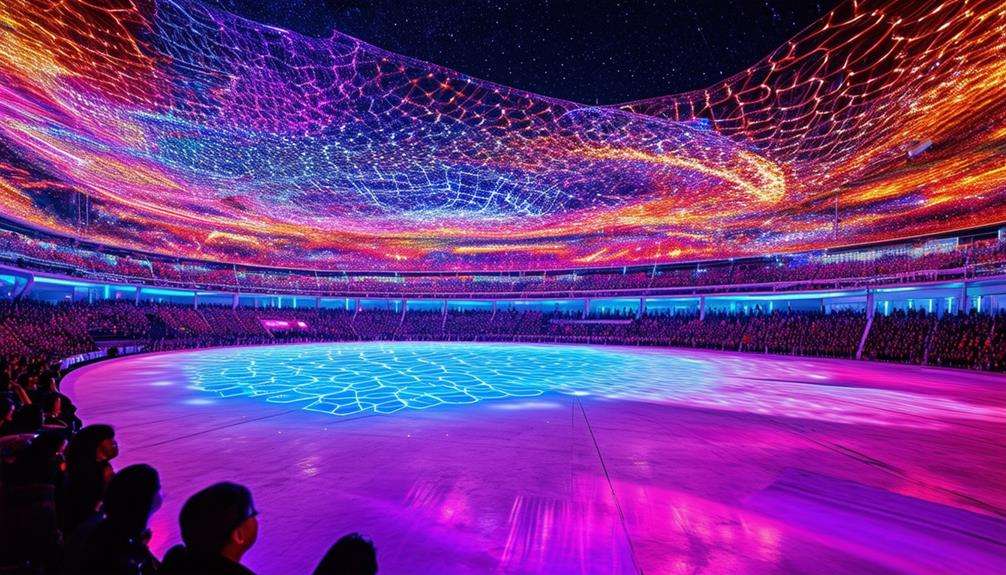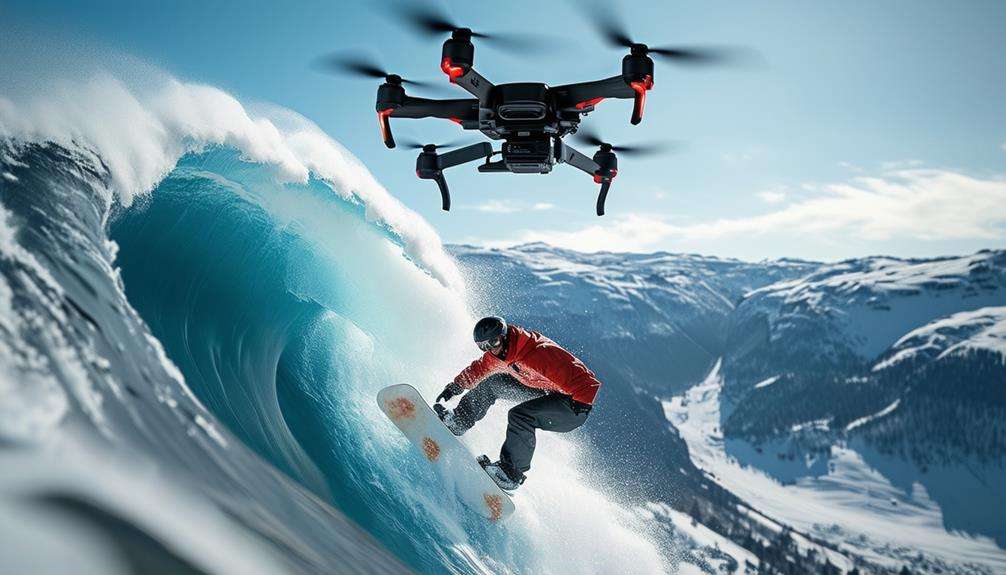Using Drones for Live Event Coverage and Streaming
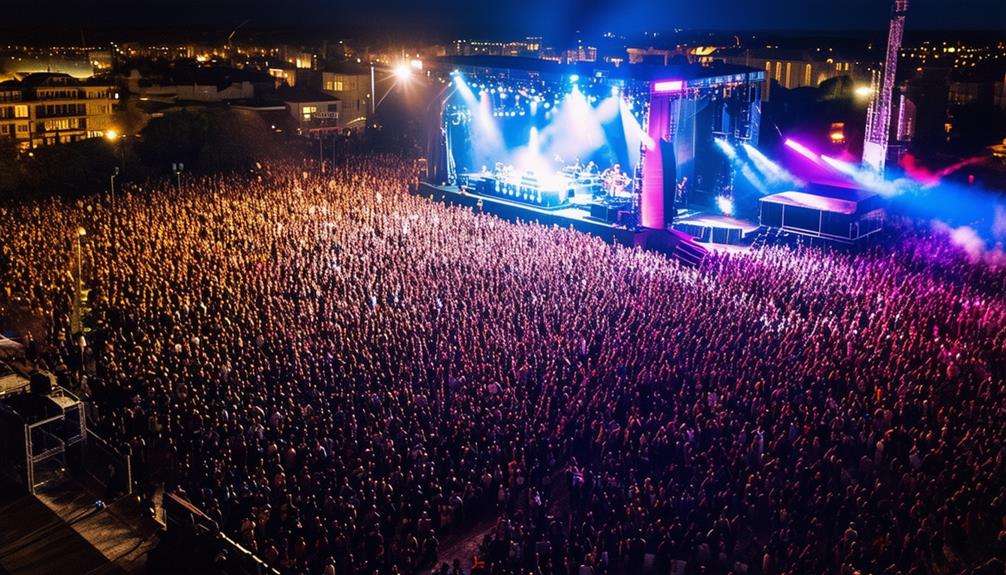
Considering the use of drones for live event coverage and streaming reveals numerous benefits—captivating aerial views, cost-effective remote coverage, and high-quality footage that enhances your viewers' experience.
Drones offer unique perspectives and dynamic footage, transforming any event. However, it's crucial to consider factors such as legal regulations, privacy concerns, and weather conditions, which can significantly impact your efforts. Addressing these considerations is essential for a seamless and successful live streaming experience. Ready to optimize your drone use? Let's explore further.
Benefits of Drone Live Streaming
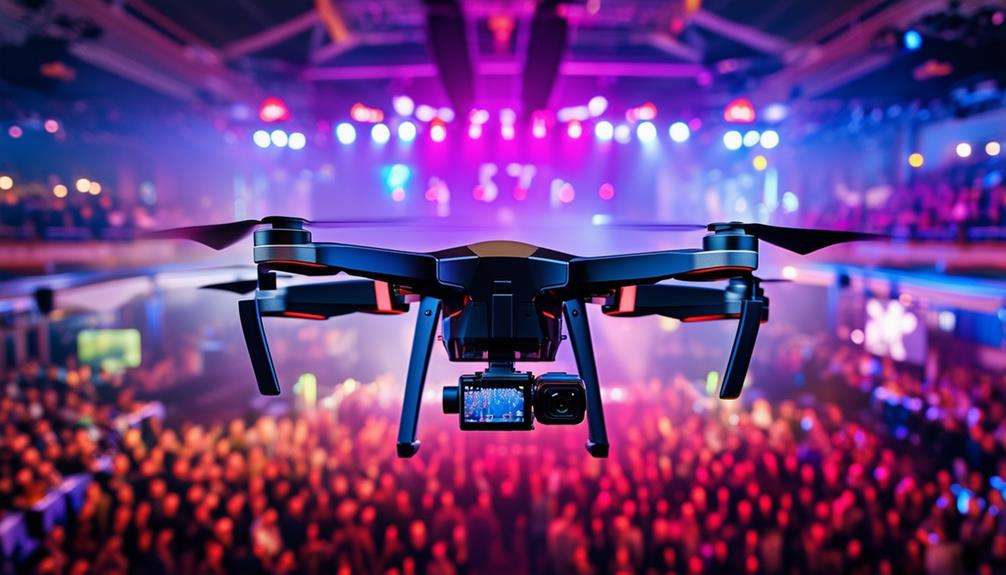
Drone live streaming offers audiences captivating aerial views that elevate the experience of any event. By providing unique and engaging real-time footage, drones have transformed the way we watch live events. Whether it's a music festival, sports game, or outdoor celebration, a drone's camera can deliver dynamic perspectives that traditional ground cameras can't achieve.
Drones can effortlessly cover remote or hard-to-reach locations, offering a cost-effective solution for event organizers. Instead of hiring extensive production crews, a few skilled operators can manage the drones, significantly reducing labor costs. Advances in drone technology have made it possible to capture high-quality, professional video footage, ensuring that the live stream is both clear and engaging.
The immersive experience that drone live streaming offers is unparalleled. Audiences feel like they're part of the action, viewing events from unique angles. This dynamic aerial footage can keep viewers engaged throughout the entire event. Ultimately, drone live streaming transforms ordinary event coverage into an extraordinary visual adventure.
Choosing the Right Drone
When selecting a drone for live event coverage, prioritize camera quality and battery life. Opt for a drone equipped with a 4K resolution camera and a 3-axis gimbal for stable and high-quality streaming. Additionally, choose a drone that offers at least 20-30 minutes of flight time to ensure uninterrupted coverage.
Camera Quality Matters
To capture stunning live event footage, selecting a drone with exceptional camera quality is vital. Ensure the drone you choose has a 3-axis gimbal-stabilized camera to keep your footage smooth and steady, crucial for live streaming. A drone with 4K resolution will deliver the crisp, clear footage your audience expects.
Next, consider the live streaming feature. Opt for drones with native livestreaming capabilities, allowing you to stream directly to platforms like YouTube or Facebook without needing extra equipment. This feature simplifies the process and ensures you're ready to go live at a moment's notice.
Additionally, look for drones with reliable transmission systems, such as OcuSync. These systems maintain a stable connection between the drone and the controller, enabling seamless streaming without interruptions.
Battery Life Considerations
After ensuring your drone's camera quality meets the highest standards, it's equally important to focus on battery life to maintain uninterrupted event coverage. A drone with a battery life of at least 20-30 minutes is essential to avoid frequent interruptions. For longer streaming sessions, consider drones with swappable batteries. This feature allows for quick battery replacement, minimizing downtime and ensuring continuous coverage.
Opt for drones equipped with intelligent battery management systems, which optimize flight time and efficiency by monitoring battery health and power usage. Keep in mind that battery life can be influenced by factors such as weather conditions, payload weight, and flying style.
For instance, flying in windy conditions or carrying heavier camera equipment can reduce flight time. To achieve extended coverage, choose a drone that balances these elements effectively. Longer battery life provides greater flexibility and ensures you capture every critical moment without interruptions.
Setting Up Your Drone
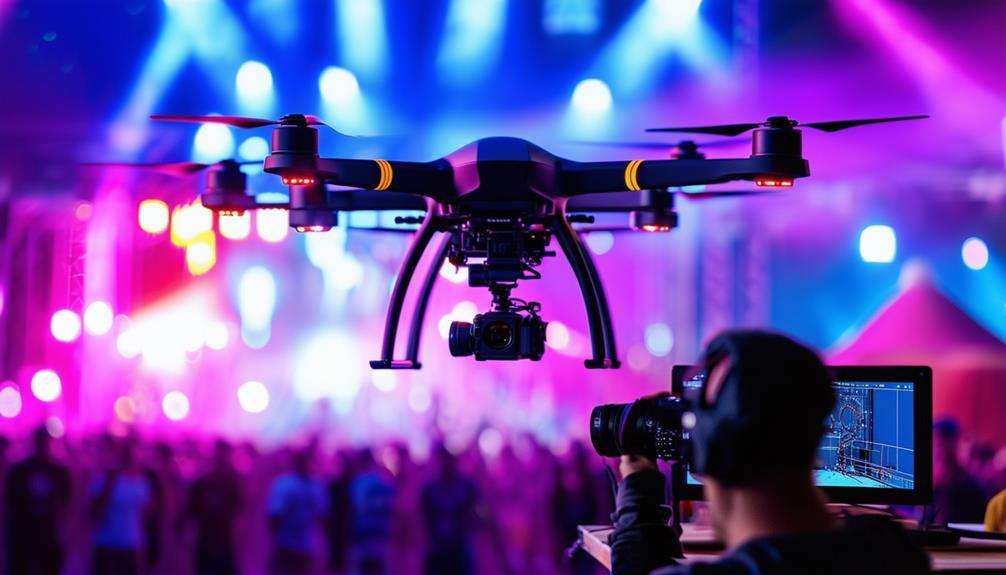
To set up your drone for live event coverage, first choose a model that meets your requirements for battery life and camera quality. Ensure the batteries are fully charged and configure the camera settings for optimal performance. Update the firmware and connect to your control app to complete the broadcasting setup.
Selecting Appropriate Drone Model
When selecting a drone for live event coverage, prioritize models with advanced features like 3-axis gimbal stabilization and 4K resolution for optimal footage quality. Ensure the drone provides smooth, high-quality imagery, crucial for engaging live streams. Moreover, look for drones that offer a flight time of at least 20-30 minutes, allowing you to capture extended footage without frequent interruptions.
Streaming capabilities are another key factor. Opt for drones with native streaming features to easily broadcast directly to platforms like YouTube or Facebook. A reliable transmission system, such as DJI's OcuSync, is essential for maintaining a steady and strong connection during live streams.
Several models stand out in the market: the DJI Mini 4 Pro, DJI Mavic 3 Pro, and DJI Avata. Each offers a combination of 3-axis gimbal stabilization and 4K resolution, making them excellent choices for live event coverage. Additionally, these models are known for their robust flight time and reliable streaming capabilities, ensuring seamless event capture from start to finish. Selecting the right drone can significantly enhance your live event coverage, so choose wisely to optimize footage quality and streaming performance.
Ensuring Battery Life
Efficiently managing your drone's battery life is crucial for uninterrupted live event coverage and successful streaming. Begin by fully charging your drone's batteries before each event. Although it may seem obvious, this initial step is critical to ensuring your drone doesn't run out of power mid-flight.
During the event, continuously monitor battery levels to plan for safe return-to-home operations, thereby preventing crashes or lost drones due to drained batteries. Consider using high-capacity batteries or carrying spares, especially for longer streaming sessions. These options can extend flight times and minimize the need for mid-event battery swaps.
Leverage your drone's battery management features to optimize power consumption. This involves adjusting settings and planning efficient flight paths. For example, minimize rapid altitude changes and avoid unnecessary maneuvers to conserve power.
Configuring Camera Settings
Setting up your drone's camera settings is crucial for capturing high-quality live event footage. To achieve the best results, start by adjusting the ISO, shutter speed, and white balance. These settings will help you manage light, motion blur, and color accuracy, essential for professional-quality streaming.
Enabling gridlines and the histogram on your display can significantly improve your framing and exposure. Gridlines help you maintain well-composed shots, while the histogram ensures balanced exposure, preventing underexposure or overexposure. For the sharpest footage, switch to manual focus. This allows you to fine-tune the focus to match the specific details of your live stream, ensuring everything appears crisp and clear.
Here's a handy table to summarize these settings:
| Feature | Purpose | Tip |
|---|---|---|
| ISO | Controls light sensitivity | Use lower ISO for bright environments |
| Shutter Speed | Affects motion blur | Use higher speed for fast action |
| White Balance | Adjusts color accuracy | Match to lighting conditions |
| Gridlines | Aids in shot composition | Enable for balanced framing |
| Histogram | Monitors exposure levels | Use to avoid clipping |
| Manual Focus | Ensures sharpness | Fine-tune for best clarity |
Experiment with these settings and save custom presets to make quick adjustments during your live stream. With the right camera settings, you'll capture stunning, professional-quality live event footage.
Essential Accessories
To optimize your drone's performance during live event coverage, equip it with essential accessories like extra batteries and propeller guards. Extra batteries are crucial for extended flight times, ensuring you capture every moment without interruptions.
Propeller guards protect your drone from collisions and damage, particularly in crowded event spaces where obstacles are common. Range extenders are another must-have. They enhance signal strength, providing more reliable connections for uninterrupted streaming, which is vital for live event coverage.
Additionally, neutral density filters help manage exposure and lighting conditions, allowing you to capture high-quality footage even in varying light environments. Don't overlook landing pads and carrying cases. Landing pads provide a stable and safe surface for takeoffs and landings, protecting your drone's undercarriage from debris and uneven ground. Carrying cases ensure your equipment is safely transported to and from events, keeping everything organized and protected from potential damage.
Optimizing Video Quality
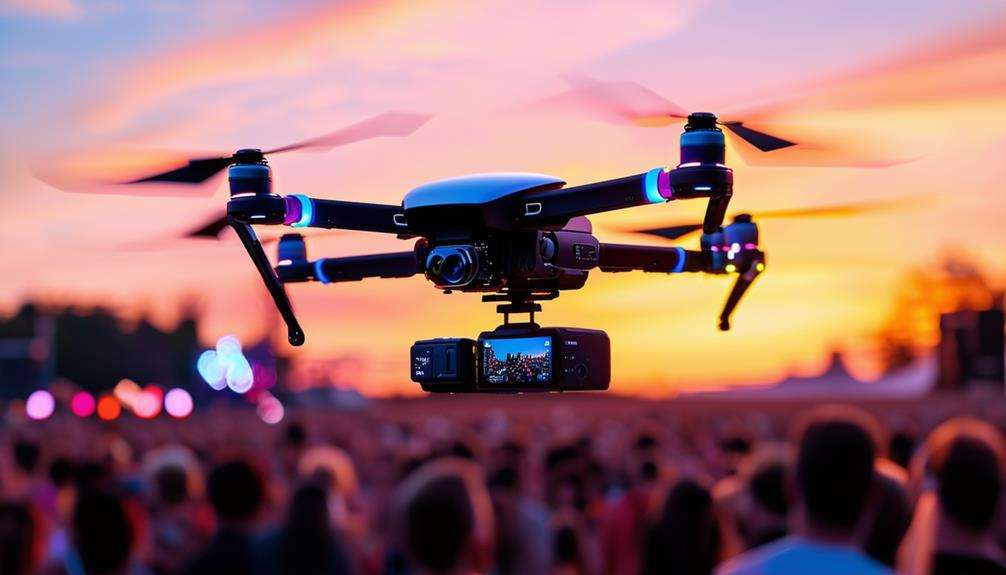
Achieving exceptional video quality for live event coverage with drones relies on using high-resolution cameras and advanced stabilization features. Equip your drone with a 4K resolution camera for sharp and detailed video. DJI drones, known for their quality and reliability, are an excellent choice.
Follow these tips to further enhance your video quality:
- Use a 3-axis gimbal:
- This keeps your footage smooth and stable, even during drone movements or windy conditions.
- Apply ND filters:
- These help manage bright outdoor lighting, preventing overexposure and maintaining balanced colors.
- Optimize your internet connection:
- A strong, stable connection is crucial to avoid buffering or disruptions during live streaming.
- Adjust camera settings:
- Tailor the settings based on the event's lighting and environment to ensure optimal video quality.
Legal and Privacy Concerns
When using drones for live event coverage, it's crucial to navigate regulatory compliance and potential privacy issues. Obtaining the necessary FAA certification and adhering to local laws can prevent legal complications. Additionally, capturing footage at crowded events without individuals' consent raises significant privacy concerns.
Regulatory Compliance Challenges
Navigating the complexities of FAA regulations and privacy laws is crucial for drone operators covering live events. Adhering to these legal requirements not only ensures compliance but also respects privacy concerns.
Key regulatory guidelines for operating drones during live event coverage include:
- FAA Regulations: Drones must be registered, and operators need the appropriate certifications for commercial use. Compliance with these rules is essential for any live event coverage.
- Privacy Concerns: Filming individuals without their consent can lead to significant legal repercussions. Always consider ethical implications and obtain necessary permissions.
- Operating Near Crowds: There are strict guidelines regarding how close drones can fly near densely populated areas, limiting coverage options but ensuring public safety.
- Non-Compliance Consequences: Ignoring regulatory requirements can result in fines, penalties, and potential legal action against both drone operators and event organizers.
Balancing the benefits of drone technology with legal and privacy considerations is critical. By understanding and following these regulations, you can achieve successful and ethical live event coverage while avoiding the risks of non-compliance.
Invasion of Privacy Issues
Adhering to FAA regulations is essential for legal compliance, but it's equally crucial to address invasion of privacy concerns to protect individuals' rights during live event coverage. Using drones without proper consideration for privacy can lead to serious violations. Capturing footage of private property or individuals without consent can constitute unauthorized surveillance, breaching ethical standards and potentially resulting in significant legal consequences.
Privacy laws are designed to protect individuals from such invasions. Violating these laws by failing to obtain consent for filming can lead to penalties and legal actions. Understanding and respecting drone use regulations that aim to protect privacy rights is paramount. Securing the necessary permissions before recording is a fundamental step to avoid these issues.
Maintaining high ethical standards requires vigilance about where and whom you're filming. Always obtain consent, especially in private areas or when individuals are prominently featured. This not only ensures legal compliance but also respects the privacy rights of those around you. Understanding these aspects helps you use drones responsibly and ethically for live event coverage.
Weather Considerations
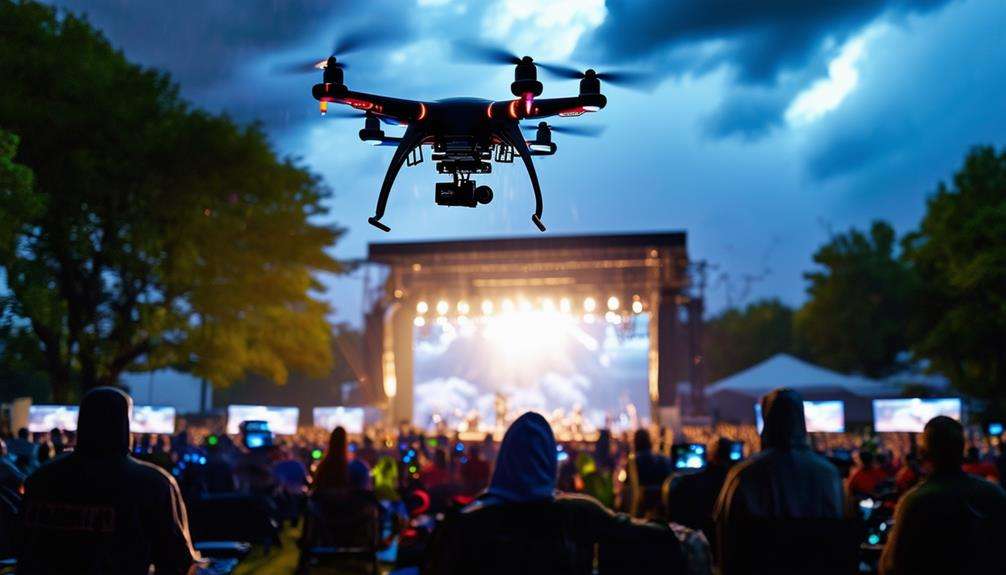
Weather conditions are crucial for the performance and safety of drones during live event coverage and streaming. Consistent monitoring of weather forecasts and real-time conditions is essential to ensure smooth operations.
Various weather elements can significantly impact drone performance and livestream quality:
- Wind Speed: High winds can destabilize drones, making it difficult to maintain steady video footage and control.
- Rain: Rain can damage sensitive drone components, leading to malfunctions and disrupted livestreaming.
- Temperature: Extreme temperatures can reduce battery life, affecting the duration of live coverage. Both high and low temperatures can also impair drone maneuverability.
- Drone Stability: Monitoring weather forecasts allows you to anticipate and mitigate potential stability issues, ensuring more reliable livestreams.
Troubleshooting Signal Issues
After considering weather conditions, it's crucial to address signal issues to ensure seamless drone performance and uninterrupted live streaming. Signal problems can stem from interference by other electronic devices or physical obstacles obstructing the drone's connection. To maintain strong connectivity, consider using signal amplifiers or range extenders, which can significantly enhance your drone's communication range and reliability.
Switching to a less crowded frequency band can also help alleviate signal issues. Many drones operate on the 2.4 GHz band, which is often congested. If your equipment supports it, switching to the 5.8 GHz band can reduce interference and improve live streaming quality. Another effective strategy is adjusting your antenna orientation. Proper alignment of antennas with your drone's position can strengthen the signal.
Regular firmware updates are essential. Manufacturers frequently release updates to optimize the drone's communication systems and address potential signal problems. Always check for and install these updates before your live streaming event.
Indoor Live Streaming
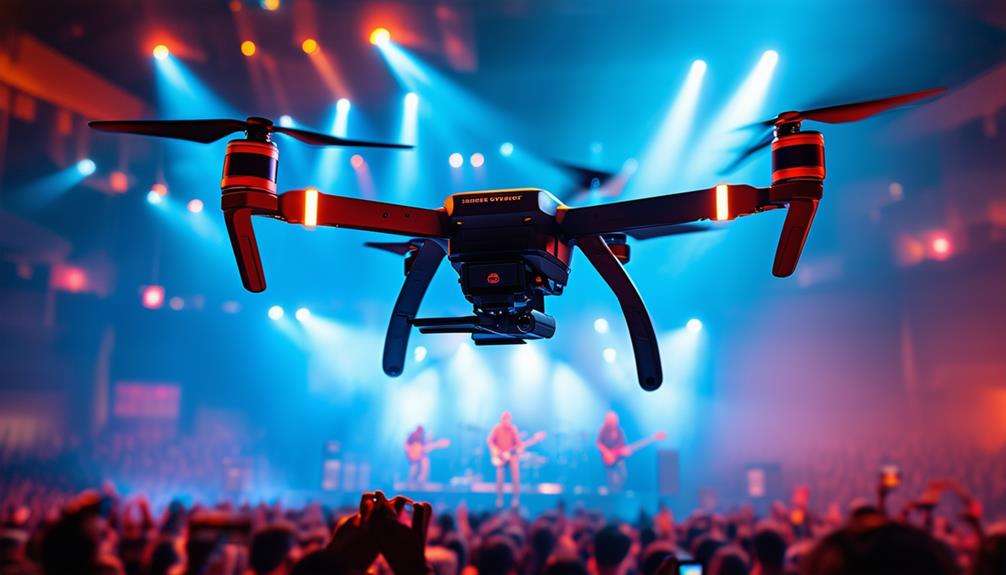
Operating drones indoors for live streaming requires exceptional skill and careful attention to obstacles like walls and ceilings. Navigating these confined spaces demands precision and steady control to avoid collisions and maintain smooth footage.
To achieve high-quality indoor live streaming, focus on these key aspects:
- Obstacle Avoidance Sensors: Equip your drone with advanced obstacle avoidance sensors. These sensors help prevent collisions with walls, ceilings, and other indoor obstacles, facilitating safer and more efficient navigation in tight spaces.
- Lighting Adjustments: Indoor lighting conditions can vary significantly. Adjust your drone's camera settings to accommodate different lighting scenarios, ensuring your live stream remains clear and visually appealing.
- Skilled Maneuvering: Master the art of flying in confined spaces. Proficient maneuvering is crucial for capturing smooth, engaging live footage. Practice flying in various indoor settings to enhance your confidence and control.
- Indoor Environment Understanding: Recognize the unique challenges of indoor settings. Unlike outdoor environments, indoor spaces often have restricted flight paths and minimal room for error. Plan your flight path meticulously to avoid accidents and ensure a seamless live streaming experience.
Real-World Examples
From capturing the excitement of the X Games to providing unique angles at the U.S. Open, drones have revolutionized live sports broadcasting. ESPN utilized drones for aerial footage of extreme sports at the X Games, offering a bird's-eye view of the action. With the DJI Fly app, operators could easily maneuver drones like the DJI Mini, equipped with a high-quality Hasselblad camera, to capture breathtaking shots.
Fox Sports has also embraced drone technology, particularly during the AMA Supercross Series. These drones delivered dynamic, close-up footage of fast-moving motorcycle races, ensuring viewers didn't miss any thrilling moments. At the U.S. Open, Fox used drones to present unique perspectives of the golf course, showcasing angles that traditional cameras couldn't achieve.
Live streams have greatly benefited from drones, especially with RTMP live streaming capabilities that ensure smooth and real-time broadcasts. Whether tracking the unpredictable movements of athletes or capturing the intensity of sports events, drones have proven indispensable.
Accessories like extra batteries and propeller guards enhance their functionality, ensuring uninterrupted coverage. With these advancements, drone usage in live event coverage isn't just a trend—it's the future.
Conclusion
Integrating drones into your live event coverage can significantly elevate your production quality by capturing stunning, dynamic footage that keeps viewers engaged. Ensure you select the appropriate drone, equip it with essential accessories, and optimize video quality.
Monitor weather conditions and be prepared to troubleshoot signal issues. Additionally, address privacy and legal concerns to ensure compliance. With these steps, you can revolutionize live streaming with breathtaking aerial views. Happy flying!

